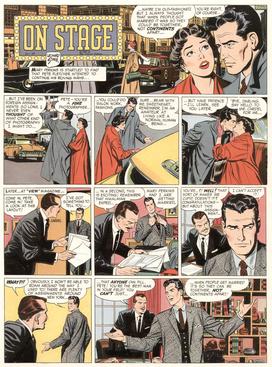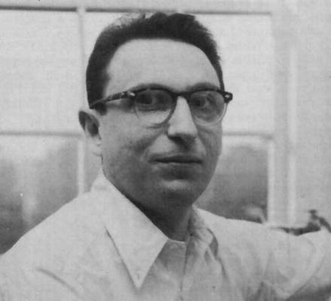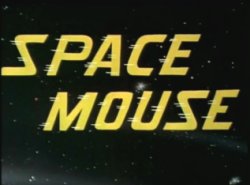
Mary Perkins, On Stage is an American newspaper comic strip by Leonard Starr for the Chicago Tribune-New York News Syndicate. It ran from February 10, 1957, to September 9, 1979, with the switch to the longer title in 1961. Some papers carried the strip under the shortened title Mary Perkins.

Scorchy Smith is an American adventure comic strip created by artist John Terry that ran from March 17, 1930 to December 30, 1961.

Harry Hershfield was an American cartoonist, humor writer and radio personality. He was known as "the Jewish Will Rogers". Hershfield also was a columnist for the New York Daily Mirror. His books include Laugh Louder, Live Longer and Now I'll Tell One. As a comics artist he is best remembered for his newspaper comic Abie the Agent.

Little Annie Rooney is a comic strip about a young orphaned girl who traveled about with her dog, Zero.
United Feature Syndicate, Inc. (UFS) is a large American editorial column and comic strip newspaper syndication service based in the United States and established in 1919. Originally part of E. W. Scripps Company, it was part of United Media from 1978 to 2011, and is now a division of Andrews McMeel Syndication. United Features has syndicated many notable comic strips, including Peanuts, Garfield, Li'l Abner, Dilbert, Nancy, and Marmaduke.

More Fun Comics, originally titled New Fun: The Big Comic Magazine a.k.a. New Fun Comics, was a 1935–1947 American comic book anthology that introduced several major superhero characters and was the first American comic book series to feature solely original material rather than reprints of newspaper comic strips. It was also the first publication of the company that would become DC Comics.

Franklin Robbins was an American comic book and comic strip artist and writer, as well as a prominent painter whose work appeared in museums including the Whitney Museum of American Art, where one of his paintings was featured in the 1955 Whitney Annual Exhibition of American Painting.
Star Hawks was a comic strip created by Ron Goulart and Gil Kane, first published on October 3, 1977, that ran through May 2, 1981. It was written through April 1979 by Goulart, followed by Archie Goodwin (1979-1980), Roger McKenzie (1980-1981) and Roger Stern. Comics veteran Gil Kane provided the artwork, with uncredited help from Ernie Colón and Howard Chaykin.

Look-in was a children's magazine centred on ITV's television programmes in the United Kingdom, and subtitled "The Junior TVTimes". It ran from 9 January 1971 to 12 March 1994. Briefly in 1985 a BBC-based rival appeared called BEEB; another was launched in 1989, Fast Forward, which went on to outsell Look-in.

The Roman Catholic Archdiocese of Madrid is one of Spain's fourteen metropolitan archbishoprics. Since 28 August 2014 the archbishop of Madrid has been Carlos Osoro Sierra.

Comic BomBom was a monthly Japanese children's manga magazine published by Kodansha. It was first published on October 15, 1981, and ceased publication in 2007. A web version of the magazine has been published on Pixiv Comic since the end of July 2017.

Crack Comics was an anthology comic book series published by Quality Comics during the Golden Age of Comic Books. It featured such characters as The Clock, Black Condor, Captain Triumph, Alias the Spider, Madame Fatal, Jane Arden, Molly the Model, and Red Torpedo. The title "crack" referred to "being at the top of one's form", like a "crack sharpshooter".
Jerry Prosser is an American comic book writer and editor, best known for his work with Dark Horse Comics.

Diana Schutz is a Canadian-born comic book editor, serving as editor in chief of Comico during its peak years, followed by a 25-year tenure at Dark Horse Comics. Some of the best-known works she has edited are Frank Miller's Sin City and 300, Matt Wagner's Grendel, Stan Sakai's Usagi Yojimbo, and Paul Chadwick's Concrete. She was known to her letter-column readers as "Auntie Dydie". She was an adjunct instructor of comics history and criticism at Portland Community College.

The first Space Mouse was a comic book character published from 1953 to around 1956 by Avon Publications. Space Mouse was also the name of a 1959 Universal Studios cartoon featuring two mice and a cat named Hickory, Dickory, and Doc. A second Space Mouse character was published by Dell Comics from 1960 to around 1965. The Dell Comics version was also featured in a 1960 cartoon produced by Walter Lantz, entitled The Secret Weapon.
The Bell Syndicate, launched in 1916 by editor-publisher John Neville Wheeler, was an American syndicate that distributed columns, fiction, feature articles and comic strips to newspapers for decades. It was located in New York City at 247 West 43rd Street and later at 229 West 43rd Street. It also reprinted comic strips in book form.
The Frank Jay Markey Syndicate was a small print syndication service that distributed comic strips and columns from the mid-1930s to c. 1950. Although small in size, the syndicate distributed strips by a number of notable cartoonists, including Ed Wheelan, Rube Goldberg, Boody Rogers, and Frank Borth. The syndicate also provided material for the burgeoning comic book industry, for companies like Quality Comics and Columbia Comics.
Associated Newspapers, Inc. was a print syndication service of columns and comic strips that was in operation from 1912 to c. 1966. The syndicate was originally a cooperative of four newspapers: The New York Globe, the Chicago Daily News, The Boston Globe, and the Philadelphia Bulletin. Associated Newspapers was led by Henry Herbert McClure (1874-1938), a cousin of S. S. McClure, founder of the McClure Syndicate, the first American newspaper syndicate. In 1930, Associated Newspapers was acquired by and became a subsidiary of the Bell Syndicate. The syndicate's most successful, long-running strip was Gladys Parker's Mopsy.
Uncle Remus and His Tales of Br'er Rabbit is an American Disney comic strip that ran on Sundays from October 14, 1945, to December 31, 1972. It first appeared as a topper strip for the Mickey Mouse Sunday page, but after the first few years, almost always appeared on its own. The strip replaced the 1932-1945 Silly Symphony strip, which had spent its final year on gag strips featuring Panchito from The Three Caballeros.

Comics Feature was an American magazine of news, criticism, and commentary pertaining to comic books, comic strips, and animation. Published by New Media Publishing, it produced 57 issues between 1980 and 1987.















